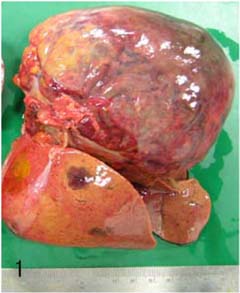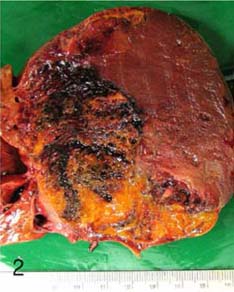J Vet Sci.
2007 Mar;8(1):103-105. 10.4142/jvs.2007.8.1.103.
Hepatocellular adenoma in a Eurasian otter (Lutra lutra)
- Affiliations
-
- 1Department of Veterinary Pathology, College of Veterinary Medicine, Seoul National University, Seoul 151-742, Korea. daeyong@snu.ac.kr
- 2Zoo and Wildlife Medicine, College of Veterinary Medicine, Seoul National University, Seoul 151-742, Korea.
- KMID: 1104244
- DOI: http://doi.org/10.4142/jvs.2007.8.1.103
Abstract
- A 7-year-old female Eurasian otter (Lutra lutra) at the Seoul Grand Park, Korea, died after displaying depression, anorexia, weight loss and rough skin for several days. At necropsy, a solitary friable round mass, which was approximately 12 x 9 x 5 cm and mottled dark red and yellow, was found bulging from the right hepatic lobe. Microscopically, the nonencapsulated, poorly circumscribed mass was composed of solid sheets of neoplastic hepatocytes. In addition, numerous small tan foci, ranging from 0.5 to 1.0 cm in diameter, were evenly scattered throughout the pancreatic tissue. These foci were found to be nonencapsulated, well-demarcated hyperplastic nodules of the exocrine pancreatic gland. We observed neither intrahepatic nor extrahepatic metastases. Based on the gross and microscopic changes, we diagnosed the animal as having a hepatocellular adenoma accompanied by exocrine pancreatic nodular hyperplasia.
Keyword
MeSH Terms
Figure
Reference
-
1. Adamson RH. Induction of hepatocellular carcinoma in nonhuman primates by chemical carcinogens. Cancer Detect Prev. 1989. 14:215–219.2. Anderson LJ, Sandison AT. Tumors of the liver in cattle, sheep and pigs. Cancer. 1968. 21:289–301.
Article3. Cullen JH, Popp JA. Meuten DJ, editor. Tumors of the liver and gall bladder. Tumors in Domestic Animals. 2002. 4th. Ames: Iowa State University Press;483–508.
Article4. Fox JG, Li X, Yan L, Cahill RJ, Hurley R, Lewis R, Murphy JC. Chronic proliferative hepatitis in A/JCr mice associated with persistent Helicobacter hepaticus infection: a model of helicobacter-induced carcinogenesis. Infect Immun. 1996. 64:1548–1558.
Article5. Kim JH, Kim BH, Kim JH, Yoo MJ, Kim DY. Lymphosarcoma in a sea otter (Enhydra lutris). J Wildl Dis. 2002. 38:616–617.6. McGlynn KA, Tsao L, Hsing AW, Devesa SS, Fraumeni JF Jr. International trends and patterns of primary liver cancer. Int J Cancer. 2001. 94:290–296.
Article7. McKillop IH, Schrum LW. Alcohol and liver cancer. Alcohol. 2005. 35:195–203.
Article8. Nakamura K, Tanimura H, Katsuragi K, Shibahara T, Kadota K. Differentiated basal cell carcinoma in a Cape clawless otter (Aonyx capensis). J Comp Pathol. 2002. 127:223–227.
Article9. Patnaik AK, Hurvitz AI, Lieberman PH. Canine hepatic neoplasms: a clinicopathologic study. Vet Pathol. 1980. 17:553–564.
Article10. Pettan-Brewer KC, Lowenstine LJ. Fowler ME, Miller RE, editors. Intrahepatic cysts and hepatic neoplasms in felids, ursids, and other zoo and wild animals. Zoo and Wild Animal Medicine: Current Therapy. 1999. 4th. Philadelphia: Saunders;423–428.11. Reddy KR, Kligerman S, Levi J, Livingstone A, Molina E, Franceschi D, Badalamenti S, Jeffers L, Tzakis A, Schiff ER. Benign and solid tumors of the liver: relationship to sex, age, size of tumors, and outcome. Am Surg. 2001. 67:173–178.12. Reimer DC, Lipscomb TP. Malignant seminoma with metastasis and herpesvirus infection in a free-living sea otter (Enhydra lutris). J Zoo Wildl Med. 1998. 29:35–39.13. Snyder RL, Tyler G, Summers J. Chronic hepatitis and hepatocellular carcinoma associated with woodchuck hepatitis virus. Am J Pathol. 1982. 107:422–425.14. Stetzer E, Williams TD, Nightingale JW. Cholangiocellular adenocarcinoma, leiomyoma, and pheochromocytoma in a sea otter. J Am Vet Med Assoc. 1981. 179:1283–1284.15. Trigo FJ, Thompson H, Breeze RG, Nash AS. The pathology of liver tumours in the dog. J Comp Pathol. 1982. 92:21–39.
Article16. Wadsworth PF, Jones DM, Pugsley SL. Primary hepatic neoplasia in some captive wild mammals. J Zoo Anim Med. 1982. 13:29–32.
Article17. Zachary JF, McDonald SC. Malignant ovarian teratoma in a spot-neck otter. J Am Vet Med Assoc. 1981. 179:1279–1283.
- Full Text Links
- Actions
-
Cited
- CITED
-
- Close
- Share
- Similar articles
-
- Ectopic migration of Dirofilaria immitis in a Eurasian otter (Lutra lutra) in Korea
- Hepatocellular Carcinoma Arising in Hepatocellular Adenoma
- Hepatocellular Carcinoma Arising from Hepatocellular Adenoma in an Elderly Male Patient
- Infections of Two Isthmiophora Species (Digenea: Echinostomatidae) in Wild Mammals from Republic of Korea with Their Morphological Descriptions
- A Case of Hepatocellular Adenoma Not Associated with Oral Contraceptive in Woman





